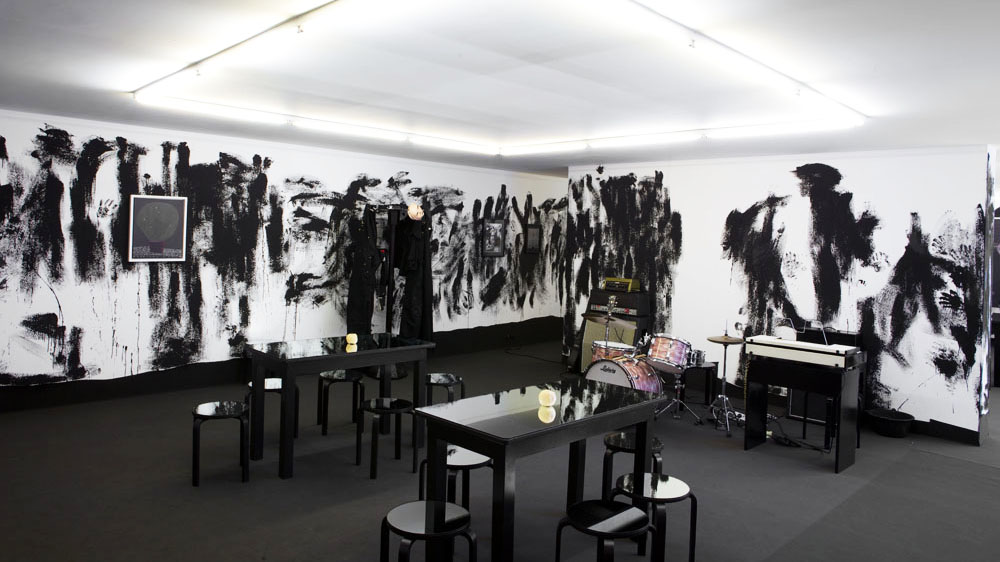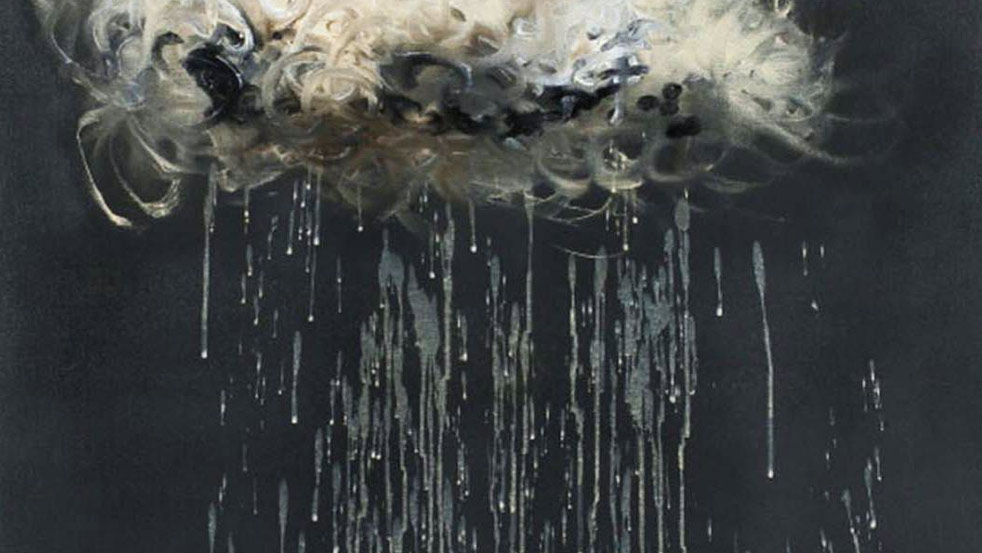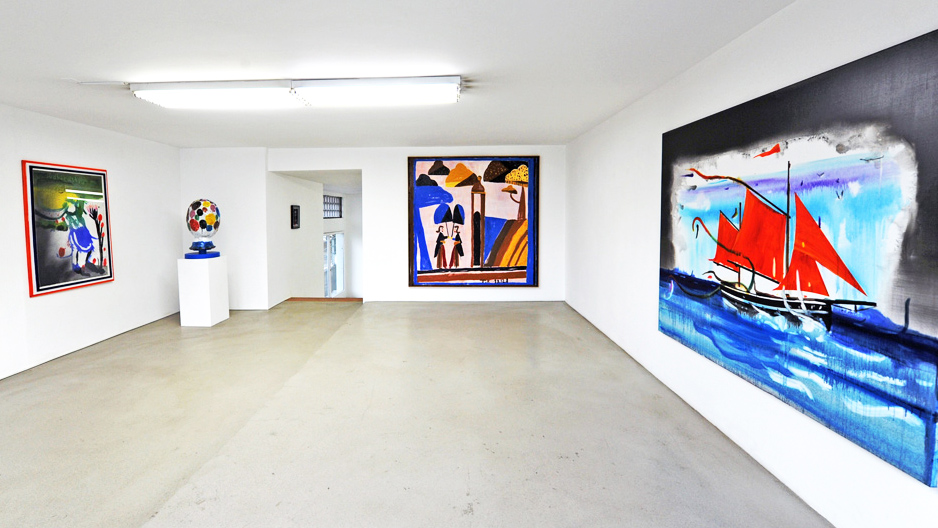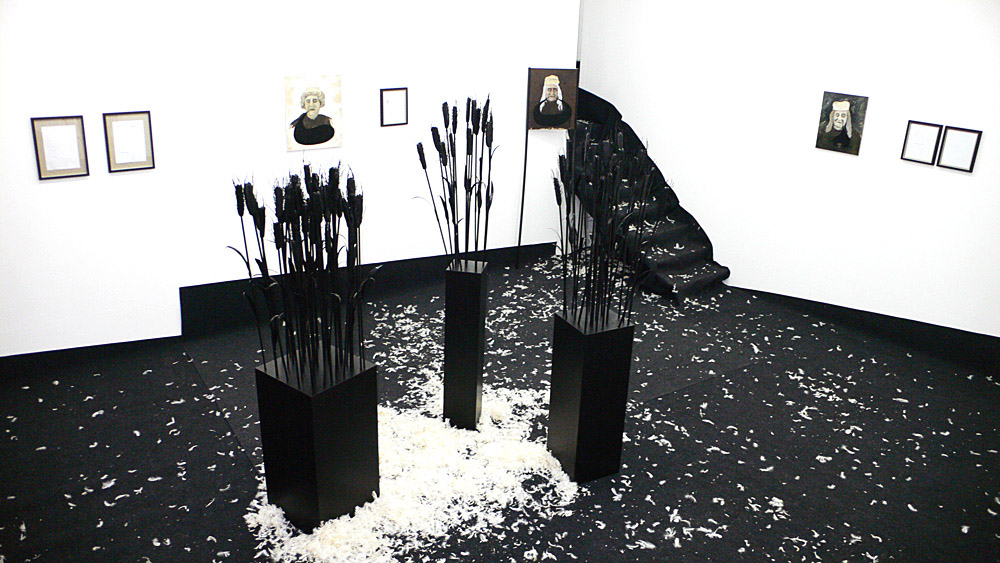Thomas Zipp
In thematic exhibitions Thomas Zipp (born in Heppenheim, 1966) conceptualizes a constellation of correlative symbols and representative histories. This topology of fact and fiction is a narrative indexing of the mind, cognition, and the unquantifiable recesses of the brain. Within comprehensive mixed-media installations, Zipp brings to the fore a forensic analysis of canonized knowledge with a thought provoking acuity of consciousness.
Through the lens of myth he symbolically views, maps, questions, and transgresses standardized historical fact. Paintings, drawings, graphics, collage, and three-dimensional works relate to social political structures promulgated by the military industrial complex, art history, science, religion, and ultimately philosophy. Zipp discursively assembles a revisionism of accepted doctrine and dares conjure their dark forces.
Seminal figures of history in his portraits have for better or worse contributed to the structure of society and our reading of it. Some have shaped policy and set far-flung agendas that constructed the paradigmatic viewpoint of the world.
Simultaneously Zipp polarizes this factual sociological dissection in pursuit of the age-old mystery of the self, and individualism. In botanical paintings pharmacology and street drugs are alluded to as vessels used to explore an interior state in the pursuit of esoteric knowledge. Theatrical settings where heavy metal music is performed emphasize a cathartic eruption of repressed feelings. At the same time the platforms allude to 19th century lecture halls as a orderly place for disseminating universal knowledge.
An installation of a “psychiatric clinic/research center” for hysteria and schizophrenia was shown last summer at the Palazzo Rossini in Venice. Inspired by David Bowie lyrics that reference Nietzsche’s writing on hysteria and the 19th century French hospital for the insane, Zipp links the culture of drugs, sex, and rock-and-roll music with the realm of psychiatry.
Zipp explores the grey zone where definitions of normalcy versus the insane are questioned with potent images of paintings, sculptural busts, hand written text scrawls, and the antagonistic gaze of collaged eyes upon the faded countenance of people.
Past exhibitions
Biography
Selected Solo Exhibitions
2021
- Thomas Zipp: Response to Transient and Steady State Flickering Stimuli, Galerie Guido W. Baudach, Berlin, Germany
2020
- Thomas Zippp: World health. Mental health 2020, Galerie Krinzinger, Vienna, Austria
- Thomas Zipp: The Church of the Magic Square, Blank, Cape Town, South Africa
2019
- Thomas Zipp: The Unknown (Flowers) & The Other Side, Martinetz, Cologne, Germany
- Thomas Zipp: Signal Hill, AVLSKARL, Copenhagen, Denmark
2018
- Thomas Zipp: A Frozen Fountain (the family of pills), Galerie Rüdiger Schöttle, Munich, Germany
- Thomas Zipp: Moon Gas – Gallery Weekend, Galerie Guido W. Baudach, Berlin, Germany
- Thomas Zipp: Physical Reality and Mental Experience (Scaling a Chimera), Galerie Bastian, Berlin, Berlin, Germany
2016
- Thomas Zipp: Attempts to quantify sensation, Baronian Xippas, Brussels (Rue Isidore Verheyden), Brussels, Belgium
2015
- Thomas Zipp: Of The Other Tomorrow, AVLSKARL, Copenhagen, Denmark
- Thomas Zipp: The Observer as a System with Feedback, Alison Jacques Gallery, Fitzrovia, London, UK
2014
- Thomas Zipp: A Psychophysical Basis for Utilitarian Comparisons (the Laerdal Experiments), Galerie Krinzinger, Vienna, Austria
- Thomas Zipp, Sommer Contemporary Art, Tel Aviv, Israel
- Thomas Zipp: Effects of Stimulus-Range and Anchor Value on Psychophysical Judgement (The Laerdal Rehearsals), Galerie Guido W. Baudach, Berlin, Germany
2013
- Thomas Zipp: Figure-Ground Specification in Terms of Structural Information. The Rivalry between Different Pattern Codings, Patricia Low Contemporary, St. Moritz, St. Moritz, Switzerland
- Thomas Zipp: Task Dependence of the Effect of Standards on the Perception of a Series of Objects, SVIT, Prague, Czech Republic
2011
- Thomas Zipp: Beyond The Superego, Galerie Krinzinger, Vienna, Austria
- Thomas Zipp, Baronian Xippas, Brussels (Rue Isidore Verheyden), Brussels, Belgium
- Thomas Zipp – The Forbidden Conduct (Deviations in conservative societies), Sommer Contemporary Art, Tel Aviv, Israel
2010
- Thomas Zipp, Galerie Rüdiger Schöttle, Munich, Germany
2009
- The World’s Most Complete Congress of Strange Birds, Patricia Low Contemporary, Gstaad, Gstaad, Switzerland
- Thomas Zipp – MENS AGITAT MOLEM (Luther & The Family of Pills), Sammlung Goetz (Goetz Collection), Munich, Germany
- Thomas Zipp: ilsatin, Galleria Francesca Kaufmann, Milan, Italy
2008
- Thomas Zipp – White Dada, Alison Jacques Gallery, Fitzrovia, London, UK
- Thomas Zipp, Sommer Contemporary Art, Tel Aviv, Israel
- Thomas Zipp: World Health. Mental Health, Sommer Contemporary Art, Tel Aviv, Israel
- DWARF NOSE, Harris Lieberman Gallery, Soho, New York, USA
- THOMAS ZIPP – S.S.B.S.M. (sick souls by sick minds), Galerie Guido W. Baudach, Wedding, Berlin, Germany
2007
- Thomas Zipp: Planet Caravan. Is There Life after Death? A Futuristic World Fair, South London Gallery, London, UK
Selected Group Exhibitions
2021
- In Case Of Boredom, Recite The ABC More Often, Krobath, Vienna, Vienna, Austria
- On The Level Or The Man Who Fell Out Of Bed, Krinzinger Projekte, Vienna, Austria
- Sourire Etroit de L’amitié, Knust Kunz, Munich (Theresienstrasse), Munich, Germany
- Portraits, Galerie Rüdiger Schöttle, Munich, Germany
- Backstage: Landscape as Vision, Galerie Guido W. Baudach, Berlin, Germany
2020
- Faces: Long Time No See!, Aurel Scheibler, Berlin, Germany
- Faces and Names, Galerie Guido W. Baudach, Berlin, Germany
- Dark Matter, Galerie Guido W. Baudach, Berlin, Germany
2019
- Installations From 25 Years Of The Falckenberg Collection, Deichtorhallen Hamburg, Falckenberg Collection, Hamburg, Germany
- 20 Years, Sommer Contemporary Art, Tel Aviv, Israel
- Children of Saturn, Rochechouart Museum of Contemporary Art, Rochechouart, France
- In Restless Dreams, Walk Alone, Sommer Contemporary Art, Tel Aviv, Israel
- Now Is The Time: 25 Years Collection Kunstmuseum Wolfsburg, Kunstmuseum Wolfsburg, Wolfsburg, Germany
2018
- Manifestations, Galerie Guido W. Baudach, Berlin, Germany
- Spiele mit der Ewigkeit, Grimmuseum, Berlin, Germany
- Dogs of the newfoundland, Baronian Xippas, Brussels (Rue Isidore Verheyden), Brussels, Belgium
2017
- Drawings & Sculptures, Sommer Contemporary Art, Tel Aviv, Israel
- Oliver Twist, Chapter 2, Rental Gallery, East Hampton, New York, USA
- The Collectors Home, AVLSKARL, Copenhagen, Denmark
- Small: An exploration of miniature, Sexauer Gallery, Berlin, Germany
2016
- The Hilger Collection. Part 1: Works on Paper and Wood, HilgerBROTKunsthalle, Vienna, Austria
2015
- Turn of a Century, Galerie Guido W. Baudach, Berlin, Germany
- Aspects of German Art (Part One), Ben Brown Fine Arts, Hong Kong, Central, Hong Kong, Hong Kong
- Painting Show – Part Two, Galerie Rüdiger Schöttle, Munich, Germany
- In Search of Lost Time, Sommer Contemporary Art, Tel Aviv, Israel
- Bare Wunder, Sies + Höke, Düsseldorf, Germany
2014
- Love Story: Anne and Wolfgang Titze Collection, Lower Belvedere, Vienna, Austria
- Franz Graf: See What Sees You, Lower Belvedere, Vienna, Austria
2013
- Post – Post – Anxiety, China Art Objects Gallery, Los Angeles, California, USA
- I knOw yoU, Irish Museum of Modern Art, Dublin, Ireland
- Meshes of the Afternoon, Sean Kelly Gallery, New York, Chelsea, New York, USA
- Heinzmann Johnson Zipp, Galerie Guido W. Baudach, Berlin, Germany
2012
- The Poster Show, Carlier / Gebauer, Berlin, Berlin, Germany
2011
- Gesamtkunstwerk: New art from German, Saatchi Gallery, London, UK
- Alptraum/Nightmare, Cell Project Space, London, UK
2010
- Superkeit, Anna Klinkhammer Galerie, Düsseldorf, Germany
- Wystawa, The Museum of Modern Art in Warsaw, Warsaw, Poland
- Thank You Mrs. Antje, Stigter Van Doesburg, Amsterdam, Netherlands
2008
- ambivalent figuration;people, Samson Projects, South End, Boston, Massachusetts, USA




